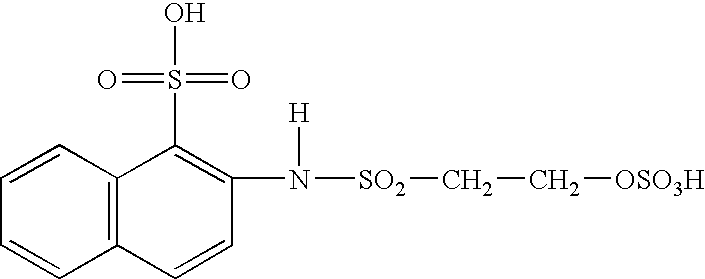Method for providing protective treatment to nylon fibers
a technology of nylon fibers and protective coatings, applied in the direction of dyeing process, heat-resistant fibres, monocomponent protein artificial filaments, etc., can solve the problems of product effectiveness loss, wet spots, etc., and achieve excellent durability and longevity, best wet fastness, and unlimited durability
- Summary
- Abstract
- Description
- Claims
- Application Information
AI Technical Summary
Benefits of technology
Problems solved by technology
Method used
Image
Examples
example 1
A 100 lb. Sample of Solutia MET light dye nylon was knitted into a tubing and dyed in a jet dye machine with 0.2% Reactive Blue 19, a bifunctional fiber reactive dye containing at least one vinyl sulfone reactive group. A 5.0% quantity of an unmodified formaldehyde condensate of 2-amino-naphtholsulfonic acid, a conventional stain blocker, was previnylized and added along with the dyestuff. The pH of the dyebath was set at 1.0 with sulfamic acid. The temperature of the dyebath was raised to 212.degree. F. and the nylon was dyed for 45 minutes. After rinsing, a quantity of 10% owf trisodium phosphate was applied to the nylon at 140.degree. F. for 15 minutes. The nylon was removed from the jet and dried continuously at 325.degree. F. A sample of the blue dyed nylon was subsequently exposed to a 24 hour Kool Aid stain test. The tested sample showed only a light stain from the cherry Kool Aid. Another sample of the same dyed nylon was washed five times at 160.degree. F. with a mild laund...
example 2
A quantity of a formaldehyde condensate of 2-amino-naphtholsulfonic acid was reacted with a sulfato-ethyl sulfone to form a modified protective entity (stainblocker) with the following structure: ##STR3##
The method of Example 1 was repeated except that this modified protective entity was substituted for the unmodified 2-amino-naphtholsulfonic acid. The modified stainblocker appeared to form covalent bonds with the nylon fiber without interfering with the bonding occurring between the Reactive Blue 19 and the fiber. The light blue yarn obtained from this dyeing showed the same initial stainblocking properties as the yarn in Example 1. However, after five washings, this sample did not stain any worse than prior to washing, indicating that covalent bonding had occurred and that the stainblocker had become permanently attached to the nylon fiber.
example 3
A dyebath may be prepared containing
1.0 g / l anionic leveling agent
2.0 g / l non-ionic wetting agent
0.3 g / l Acid Yellow 151
0.5 g / l formic acid
This dyebath may be uniformly applied to a carpet sample tufted from 1360 denier Solutia KET medium dyeable nylon at a 400% wet pick-up. The sample may be steamed for 6 minutes, washed and dried.
A second sample may be run by the same procedure except that 25 g / l of the modified protective stainblocker described in Example 2 may be previnylized and added to the dyebath. After steaming, this second sample may be exposed to a rinse containing 20 g / l of TSP for 20 seconds before washing and drying.
If the two yellow dyed samples are subjected to the 24 hour Kool Aid stain test, it is anticipated that the first sample will exhibit a heavy red stain whereas the second sample will show only a very light stain. If a section of the second sample is then steam cleaned ten times and exposed to the 24 hour Kool Aid stain test, it is anticipated that the sampl...
PUM
| Property | Measurement | Unit |
|---|---|---|
| pH | aaaaa | aaaaa |
| temperature | aaaaa | aaaaa |
| temperature | aaaaa | aaaaa |
Abstract
Description
Claims
Application Information
 Login to View More
Login to View More - R&D
- Intellectual Property
- Life Sciences
- Materials
- Tech Scout
- Unparalleled Data Quality
- Higher Quality Content
- 60% Fewer Hallucinations
Browse by: Latest US Patents, China's latest patents, Technical Efficacy Thesaurus, Application Domain, Technology Topic, Popular Technical Reports.
© 2025 PatSnap. All rights reserved.Legal|Privacy policy|Modern Slavery Act Transparency Statement|Sitemap|About US| Contact US: help@patsnap.com



